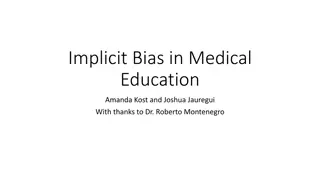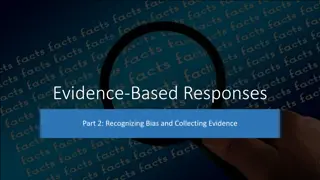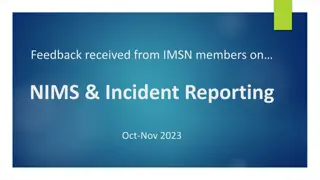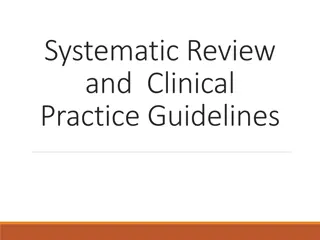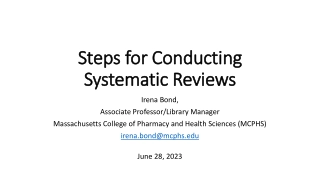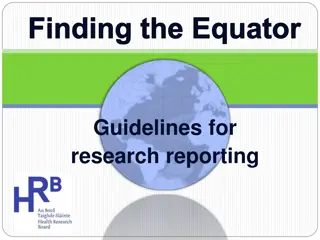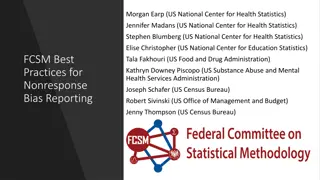Managing Reporting Bias in Systematic Reviews - Strategies and Consequences
Reporting bias poses a significant threat to the accuracy of systematic reviews, with publication bias affecting up to 50% of trials. This bias distorts treatment effect estimates, leading to exaggerated outcomes. Strategies to mitigate reporting bias include searching bibliographical databases, exploring unpublished trials through conference abstracts and clinical trial registries, and ensuring trial registration compliance. Failure to address reporting bias can result in biased systematic reviews with distorted efficacy and safety assessments.
- Reporting Bias
- Systematic Reviews
- Publication Bias
- Trial Registration Compliance
- Clinical Trial Registries
Download Presentation

Please find below an Image/Link to download the presentation.
The content on the website is provided AS IS for your information and personal use only. It may not be sold, licensed, or shared on other websites without obtaining consent from the author. Download presentation by click this link. If you encounter any issues during the download, it is possible that the publisher has removed the file from their server.
E N D
Presentation Transcript
Beyond database searching for relevant studies Le Cleach L, Doney E, Katz KA, Williams HC, Trinquart L. RTMS: Workflow for Searching Databases to Reduce Evidence Selection Bias in Systematic Reviews. J Invest Dermatol. 2016 Dec;136 (12):e125-e129.
Reporting Bias is the greatest threat to the validity of systematic reviews Publication bias: 25% to 50% of trials are never reported Trials with negative results are twice as likely to remain unpublished as those with positive results Outcome reporting bias: Around half of published trials have at least one primary outcome that was changed, introduced, or omitted Positive outcomes have increased odds of being reported Jones CW et al. BMJ 2013; Scherer, R. W. et al. Cochrane Database Syst. Rev. 2007
Consequences of reporting bias The results of a systematic review based on a sample of trials not representative of all existing trials will be biased Treatment effect estimates for efficacy and safety will be distorted and likely exaggerated No statistical method allows excluding of reporting bias in systematic review with certainty (Funnel plot ) Dwan, K. et al. PloS One ,2013;Hart, B., Lundh, A. &Bero, L.. BMJ 2012. Kirkham JJ et al. BMJ 2010 Ioannidis JP. J Eval Clin Pract 2008;
FIND THE PUBLISHED TRIALS Main bibliographical databases CENTRAL (Cochrane Central Register of Controlled Trials) MEDLINE EMBASE Specialized bibliographical databases for specific topics Reference lists of included studies Studies included in previous systematic reviews
FIND THE UNPUBLISHED TRIALS: CONFERENCE ABSTRACT 50% unpublished No centralized registry Hand or electronically search American Academy of Dermatology, Society for Investigative Dermatology, CSG Specialized Register (28 conference proceedings) Scherer, R.W et al Cochrane Database Syst Rev 2007
FIND THE UNPUBLISHED TRIALS: Clinical trial registries Aims to overcome reporting bias issue Databases of planned, ongoing and completed trials Trial registration is a legal requirement in the United States, European Union, , and ICJME requirement for publication WHO International Clinical Trials Registry Platform Search Portal 16 data providers (clinicaltrials.gov ) Anderson LM et al. MEJM 2015
One example: Contact the trialists or sponsors to inquire about the trial status and results
Registries to detect outcome reporting bias Primary and secondary outcomes are documented in trial record Compare pre-specified outcomes in the trial record /reported outcomes, in the published article
Clinical trial registries: summary trial data FDA in 2009 The results (for some trials) required to be posted at clinicaltrials.gov within 12 months after completion Compliance is far from perfect. Anderson LM et al. MEJM 2015
Search for unpublished trials: regulatory agency websites FDA : searchable catalog of approved drug products EMA : European public assessment reports (EPAR) for every medicine application, (granted or refused a marketing authorization) Their inclusion can result in modification of the conclusions of MA. Hart, B., et al. BMJ 2012
FDA http://www.accesdata.fda.gov/scripts/cder/daf/
EMA http://www.ema.europa.eu/ema/index.jsp?curl=pages/medicines/landi ng/epar_search.jsp
The imiquimod AND molluscum story Cochrane review in 2009 1 published RCT: imiquimod vs placebo (23 patients) RR 3.67 (95% CI 0.48-28.0) for complete clearance of lesions FDA s publicly available review 3 unpublished trials (827 patients) pooled RR 0.93 (95%CI 0.73-1.19) Suggesting that imiquimod is ineffective for that indication van der Wouden et al., 2009.Katz KA, Swetman GL. Pediatrics. 2013
Which primary source information ? In case of discrepancies for results between different multiple reports for the same trial FDA-prepared documents Statistical reviewers reanalyze raw data Clinicaltrial.gov : AE Journal articles Possible selective reporting of a subset of statistical analyses Hartung et al., 2014; Tang E et al.BMC Med. 2015
Future of transparency http://opentrials.net/ Aggregate information from a wide variety of existing sources to provide a comprehensive picture of the data and documents on all trials alltrials.net campaign Initiative of organizations such as Cochrane, The BMJ, calling for registration and reporting of results of all clinical trials. ICJME Proposes to require authors to share with others the individual-patient data as a condition for publication of a clinical trial Taichman et al., 2016
The clinicalstudydatarequest.com and the Yale University Open Data Researchers can request access to individual patient data and supporting documents from industry-sponsored clinicaltrials. European Medicines Agency Guidance on the publication of clinical data for medicinal products 2015 for the publication of clinical reports, in a later stage individual patient data.
Challenge Not miss data that will change MA results But...not be drowned







